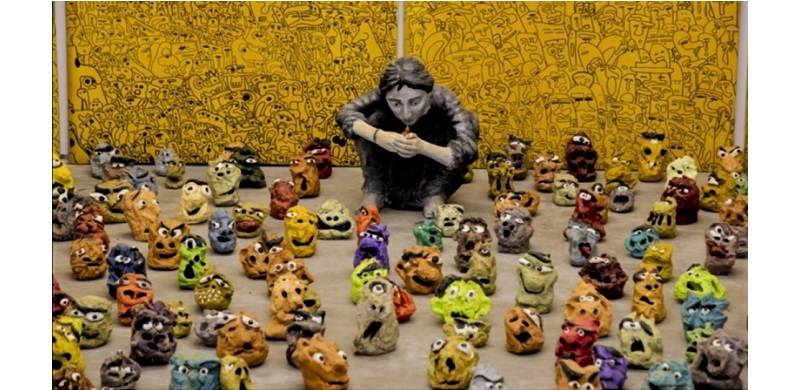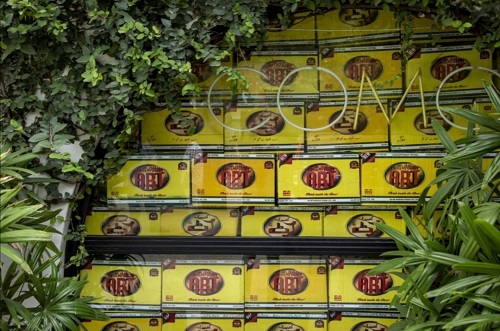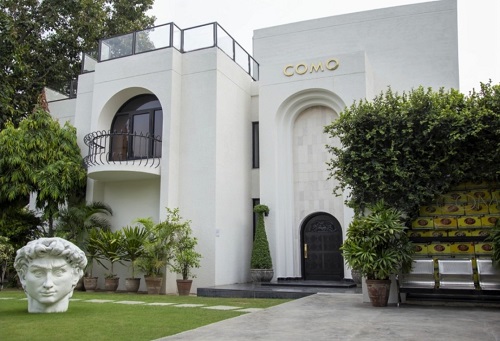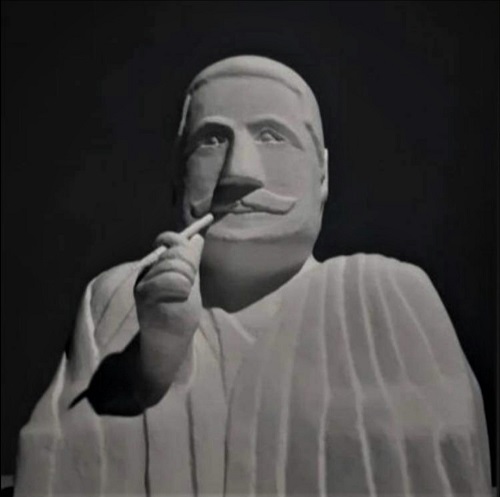
Sculpture is essentially perceived as a three-dimensional, static, solid object-based practice – usually executed in a single dominant material, and the word ‘sculptor’ originally means a carver. Today, this definition would seem rather too restricted.
The Western tradition has been consistent in the use of the base as an appurtenance to sculpture. Within the representational idiom in general, the base has served to isolate and emphasise the particular psychology and anecdotal content of the activity it supports.
That sculpture could be created by setting any object upon a base became a chief dialectical dilemma of modern sculpture. It is in the 20th century – accelerated in the 1970s and ‘80s – that sculpture was slowly taken off the plinth, and the former methods of making sculpture like modeling, casting and carving were not as extensively used, being replaced by sticking together or stacking, which needed no manual dexterity to execute.
The modern sensibility has progressively attempted to break down the psychic barrier, the traditional object-viewer relationship, that accounts for the transcendent qualities of sculpture. It has tried to substitute an environment where observer and object are given a like status. Raising an object to humanness or super-humanness is no longer an issue. What is important is a naturalness where things – both objects and organisms – are accepted for what they are, not for what they represent.
When an artist uses a 3-dimensional work in a specific space with the intent of changing the perception of that space, the work transcends the realm of sculpture and turns into an installation work. Installation art effectively inverts the principles of sculpture. Sculpture is meant to be viewed from the outside as a self-contained arrangement of forms, in comparison to installations that often envelope the viewer in the space of the work. As a result, the space isn't space any more but a "site" now. These shifts in perception are not just visual but also cultural, as the artist draws out the social history of the not just the site but also the constituent objects or elements used in the Installation. Installation art functions more on a sensorial level and has more to do with engagement. And so, installations can be permanent or time-based depending upon the nature of the work.
With what is understood as installation art now, formal sculpture is compromised in order to create a subject-object relationship where the understanding of the whole is constructed and reconstructed by spectators. Aware of the fact that in context of contemporary art, these definitions/categories tend to overlap and blur, I still personally prefer to keep them segregated – because as an artist with formal art training, I cannot totally free myself of the burden of history. And history clearly states that installation art as a discipline negated the very notions of the white cube by altering the context and meaning of objects. Also, it attempted to free art of its commercial aspect. It questioned commodification by producing an experience as opposed to the traditional, sellable "objet d'art".

Sculpture at Como through the lens of Baudrillard
Simulacra and Simulation is the title of a 1981 book by French philosopher Jean Baudrillard. It is a formal philosophical text in which he formulates a theory about cultural materialism, concerned with the role that images play in contemporary society and the way that reality is mediated by these images.
Simulacra refers to the representation of images/things that either had no reality to begin with, or ones that no longer have an original.
Baudrillard claims that modern society has “replaced all reality and meaning with realistic versions of reality" that are real to the extent that they become inseparable from reality itself. And so, all of human experience is a simulation of reality: an imitation of an imitation. This infinite mutability results in the total loss of meaning.
He interprets the distinction between notions of "reality" and "simulation of reality" by drawing an analogy between maps (a representation of the real world) and the real world to explain postmodern culture. He refers to our use and reliance on maps resulting in a disconnect with the real world. Baudrillard states:
"The territory no longer precedes the map, nor does it survive it. It is nevertheless the map that precedes the territory—precession of simulacra—that engenders the territory. Cultural Materialism is no longer a question of imitation, nor duplication, nor even parody: It is a question of substituting the signs of the real for the real.”
Nausheen Saeed's harmonious arrangement of stacked topographies manifests the map preceding the territory, an intentional subversion of the real resulting in liberation from age-old ideological constructs of wealth, power, heritage and history.
The simulacra that Baudrillard refers to are the manifestations of the manner in which the symbolism of culture and media constructs perceived reality. He elaborates the phenomenon of “precession of simulacra" (sign order) in four steps/stages, by identifying each with a period in history.

(1) Reflection: symbols which are a good appearance or faithful copy
What Baudrillard terms “the sacramental order” is the first order of simulacra, which he associates with the pre-modern period. It is evoked in Hidayat Marwat's rendition of David: the image is a clear counterfeit of the real, recognised as just an illusion, a place marker for the real; where we believe – and it may even be correct – that a sign is a “reflection of a profound reality.”
(2) Distortion: symbols as a perverted appearance or unfaithful copy
The second order of simulacra pertains to the travesty or perversion of reality whereby signs and images/representations do not faithfully reveal reality to us, instead hint at an obscure reality that the sign itself fails to encompass. Baudrillard refers to it as the order of maleficence.
Emanating from the subconscious, Arfa Shah's sea of polychromatic demented baked terracotta caricatures or Irfan Abdullah's concrete tablets embedded with tiny, irregular razor blade shavings in a linear fashion mask and denature reality , transmuting it into an evil entity.
(3) Pretence/Mask: symbols as a cover-up pretending to be a faithful copy
In the third order of simulacra, which Baudrillard associates with the Industrial Revolution of the 19th century, the distinctions between the image and the representation begin to blur because of mass production and the proliferation of copies, turning them into commodities.
Mahbub Jokhio's systematic arrangement of boxes of art – or boxes as art – masks the absence of a profound reality, where the simulacra pretends to be a faithful copy, but it is a copy with no original. The commodity’s ability to imitate reality threatens to replace the authority of the original version, because the copy is just as “real” as its prototype.
(4) Pure simulacrum: has no relation to reality whatsoever
Baudrillard associates the fourth and final order of simulacra with the postmodernity of Late Capitalism, describing it as the “precession of simulacra” whereby the representation precedes and determines the real. Reality and representation become homogenous, imitation is fact. "Assi Gallan Karday Reh Gaye, Te Bazi Le Gaye Mali" – Ayaz Jokhio's ode to the gardeners of Gulshan-e-Iqbal by mimicking their version of the poet Allama Iqbal questions the very notions of artistic originality, simultaneously rendering originality as a totally meaningless concept/construct.
***
Simulation is the imitation of the functionality of a real-world process or system over time.
Referring to simulations as the "hyperreal," Baudrillard argues that they have escalated to the level where they compose our understanding of reality: a representation so realistic that it cannot be distinguished as a representation but is treated as reality. In order to illustrate the difficulty of determining the real from the simulated, he offers the example of illness – to dissimulate is to feign not to have what one has. To simulate is to feign to have what one hasn't. One implies a presence, the other an absence. But the matter is more complicated, since to simulate is not simply to feign: "Someone who feigns an illness can simply go to bed and make believe he is ill. Some who simulates an illness produces in himself some of the symptoms." Thus, feigning or dissimulating leaves the reality principle intact: the difference is always clear, it is only masked; whereas simulation threatens the difference between "true" and "false", between "real" and "imaginary."
Yumna's "Apple in a Process of Death" and Sadqain's "Grime" are both time-based installations which portray time as the transformative force – highlighting the temporality of objects. These objects are undergoing changes in form and meaning every passing instant: decay in the former, osmosis in the latter.
The Western tradition has been consistent in the use of the base as an appurtenance to sculpture. Within the representational idiom in general, the base has served to isolate and emphasise the particular psychology and anecdotal content of the activity it supports.
That sculpture could be created by setting any object upon a base became a chief dialectical dilemma of modern sculpture. It is in the 20th century – accelerated in the 1970s and ‘80s – that sculpture was slowly taken off the plinth, and the former methods of making sculpture like modeling, casting and carving were not as extensively used, being replaced by sticking together or stacking, which needed no manual dexterity to execute.
The modern sensibility has progressively attempted to break down the psychic barrier, the traditional object-viewer relationship, that accounts for the transcendent qualities of sculpture. It has tried to substitute an environment where observer and object are given a like status. Raising an object to humanness or super-humanness is no longer an issue. What is important is a naturalness where things – both objects and organisms – are accepted for what they are, not for what they represent.
When an artist uses a 3-dimensional work in a specific space with the intent of changing the perception of that space, the work transcends the realm of sculpture and turns into an installation work. Installation art effectively inverts the principles of sculpture. Sculpture is meant to be viewed from the outside as a self-contained arrangement of forms, in comparison to installations that often envelope the viewer in the space of the work. As a result, the space isn't space any more but a "site" now. These shifts in perception are not just visual but also cultural, as the artist draws out the social history of the not just the site but also the constituent objects or elements used in the Installation. Installation art functions more on a sensorial level and has more to do with engagement. And so, installations can be permanent or time-based depending upon the nature of the work.
With what is understood as installation art now, formal sculpture is compromised in order to create a subject-object relationship where the understanding of the whole is constructed and reconstructed by spectators. Aware of the fact that in context of contemporary art, these definitions/categories tend to overlap and blur, I still personally prefer to keep them segregated – because as an artist with formal art training, I cannot totally free myself of the burden of history. And history clearly states that installation art as a discipline negated the very notions of the white cube by altering the context and meaning of objects. Also, it attempted to free art of its commercial aspect. It questioned commodification by producing an experience as opposed to the traditional, sellable "objet d'art".

Sculpture at Como through the lens of Baudrillard
Simulacra and Simulation is the title of a 1981 book by French philosopher Jean Baudrillard. It is a formal philosophical text in which he formulates a theory about cultural materialism, concerned with the role that images play in contemporary society and the way that reality is mediated by these images.
Simulacra refers to the representation of images/things that either had no reality to begin with, or ones that no longer have an original.
Baudrillard claims that modern society has “replaced all reality and meaning with realistic versions of reality" that are real to the extent that they become inseparable from reality itself. And so, all of human experience is a simulation of reality: an imitation of an imitation. This infinite mutability results in the total loss of meaning.
He interprets the distinction between notions of "reality" and "simulation of reality" by drawing an analogy between maps (a representation of the real world) and the real world to explain postmodern culture. He refers to our use and reliance on maps resulting in a disconnect with the real world. Baudrillard states:
"The territory no longer precedes the map, nor does it survive it. It is nevertheless the map that precedes the territory—precession of simulacra—that engenders the territory. Cultural Materialism is no longer a question of imitation, nor duplication, nor even parody: It is a question of substituting the signs of the real for the real.”
Nausheen Saeed's harmonious arrangement of stacked topographies manifests the map preceding the territory, an intentional subversion of the real resulting in liberation from age-old ideological constructs of wealth, power, heritage and history.
The simulacra that Baudrillard refers to are the manifestations of the manner in which the symbolism of culture and media constructs perceived reality. He elaborates the phenomenon of “precession of simulacra" (sign order) in four steps/stages, by identifying each with a period in history.

(1) Reflection: symbols which are a good appearance or faithful copy
What Baudrillard terms “the sacramental order” is the first order of simulacra, which he associates with the pre-modern period. It is evoked in Hidayat Marwat's rendition of David: the image is a clear counterfeit of the real, recognised as just an illusion, a place marker for the real; where we believe – and it may even be correct – that a sign is a “reflection of a profound reality.”
(2) Distortion: symbols as a perverted appearance or unfaithful copy
The second order of simulacra pertains to the travesty or perversion of reality whereby signs and images/representations do not faithfully reveal reality to us, instead hint at an obscure reality that the sign itself fails to encompass. Baudrillard refers to it as the order of maleficence.
Emanating from the subconscious, Arfa Shah's sea of polychromatic demented baked terracotta caricatures or Irfan Abdullah's concrete tablets embedded with tiny, irregular razor blade shavings in a linear fashion mask and denature reality , transmuting it into an evil entity.
(3) Pretence/Mask: symbols as a cover-up pretending to be a faithful copy
In the third order of simulacra, which Baudrillard associates with the Industrial Revolution of the 19th century, the distinctions between the image and the representation begin to blur because of mass production and the proliferation of copies, turning them into commodities.
Mahbub Jokhio's systematic arrangement of boxes of art – or boxes as art – masks the absence of a profound reality, where the simulacra pretends to be a faithful copy, but it is a copy with no original. The commodity’s ability to imitate reality threatens to replace the authority of the original version, because the copy is just as “real” as its prototype.

(4) Pure simulacrum: has no relation to reality whatsoever
Baudrillard associates the fourth and final order of simulacra with the postmodernity of Late Capitalism, describing it as the “precession of simulacra” whereby the representation precedes and determines the real. Reality and representation become homogenous, imitation is fact. "Assi Gallan Karday Reh Gaye, Te Bazi Le Gaye Mali" – Ayaz Jokhio's ode to the gardeners of Gulshan-e-Iqbal by mimicking their version of the poet Allama Iqbal questions the very notions of artistic originality, simultaneously rendering originality as a totally meaningless concept/construct.
***
Simulation is the imitation of the functionality of a real-world process or system over time.
Referring to simulations as the "hyperreal," Baudrillard argues that they have escalated to the level where they compose our understanding of reality: a representation so realistic that it cannot be distinguished as a representation but is treated as reality. In order to illustrate the difficulty of determining the real from the simulated, he offers the example of illness – to dissimulate is to feign not to have what one has. To simulate is to feign to have what one hasn't. One implies a presence, the other an absence. But the matter is more complicated, since to simulate is not simply to feign: "Someone who feigns an illness can simply go to bed and make believe he is ill. Some who simulates an illness produces in himself some of the symptoms." Thus, feigning or dissimulating leaves the reality principle intact: the difference is always clear, it is only masked; whereas simulation threatens the difference between "true" and "false", between "real" and "imaginary."
Yumna's "Apple in a Process of Death" and Sadqain's "Grime" are both time-based installations which portray time as the transformative force – highlighting the temporality of objects. These objects are undergoing changes in form and meaning every passing instant: decay in the former, osmosis in the latter.

